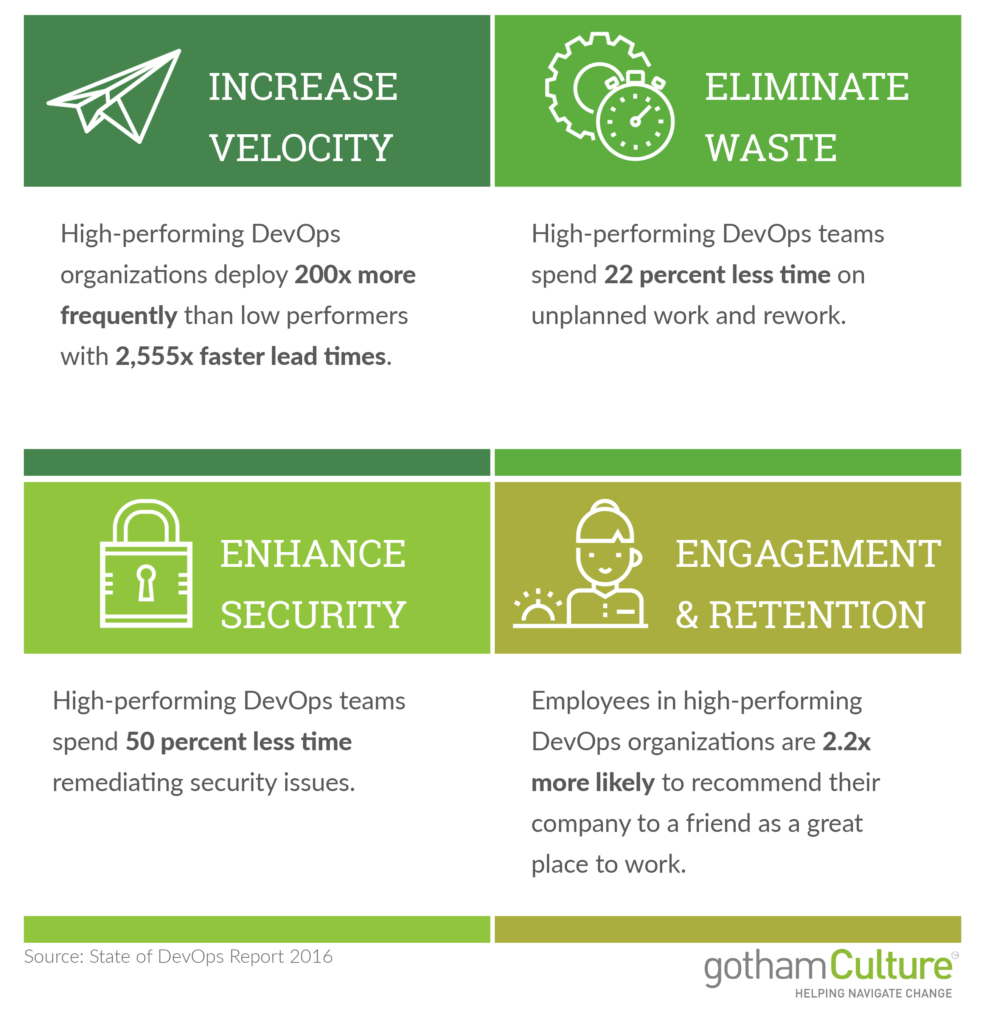Today, organizations must delight customers, beat competitors to market, and pivot quickly when needed. The increasing rate of change in today’s complex business environment demands more value in less time. And quite often, the ability to deliver quality software quickly and reliably is what drives success in this new world of business value.
In finance, the most innovative banks have developed technology that allows us to deposit and manage money from our smartphones. Apple and Pandora help us discover and purchase music within seconds of release. Successful retailers are finding innovative ways to eliminate friction in the customer experience, allowing us to purchase, make returns, and offer recommendations, all without stepping outside our homes.
When organizations keep up with the velocity of technological change, they possess an undoubtable competitive advantage over their peers. And many of these innovative organizations are adopting a DevOps methodology to reach the velocities they need. But this methodology isn’t just about improving technology and revamping processes. Organizational culture plays a critical role in promoting the behaviors required to safely sustain the faster pace.
Birthed out of Agile software development and Lean methodologies, and raised amid tectonic architectural shifts like micro-services, containers, and cloud, the DevOps movement focuses on tools, process, and culture to increase software development and delivery velocity.
The Primary DevOps Challenge
Due to the nature of their work, CIOs and other tech leaders understand what it takes to make an organization a technological innovator. Others, however, still struggle to understand that the ability to deliver a quality product (high-quality code in this case) with speed and stability is the heart of innovation and customer satisfaction.
Adding further complexity is the fact that many leaders, though they understand the immense impact DevOps can have on their businesses, don’t quite understand where to start with a transformation of this magnitude.
This is largely due to the fact that DevOps is not entirely a technology solution. It is also a fundamental shift in the way organizations structure themselves to get work done in a completely new way — a culture shift that challenges the beliefs and assumptions that people hold true about each other, themselves, and their work.
So, how can these organizations begin to understand how they should evolve to stay competitive?
Assessing Your DevOps Readiness
First, measuring and understanding your current state baseline is critical. A valid and reliable assessment ensures you are in a position to change, assists in helping leaders understand the potential obstacles that currently exist in the system, and helps organize and prioritize the change activities that must happen in order to embed these new ways of working into the cultural fabric of your company.
DORA, the DevOps Research and Assessment team founded by some of the most prominent thinkers and researchers on the subject — Jez Humble, Nicole Forsgren, Ph.D. and Gene Kim — is best known as a driving force behind the annual State of DevOps report, which represents the latest research and insights into the topic.
The team at DORA have designed and validated a quantitative assessment called the DevOps Scorecard to help organizations gain a baseline understanding of where their organizations sit with regard to four primary categories of IT capabilities: Technical, Process, Measurement, and Culture.
Comparing business units to the organization overall, while also benchmarking them against other high-performing organizations across the industry, leaders can quickly gain insight into current capabilities. The Scorecard also provides a priority analysis, allowing organizations to strategically make resource allocation and capability development decisions. This provides a clear roadmap for a DevOps transformation.
“Many organizations employ a “one size fits all” approach to implementing agile and DevOps,” says Jez Humble, CTO of DORA and author of Continuous Delivery, Lean Enterprise, and The DevOps Handbook. “The DORA Scorecard shows you exactly where to invest in capability development to produce the biggest impact in software delivery performance.”
Software delivery performance is the ability to deliver code quickly and reliably. DORA focuses on this aspect of software performance because it has been shown to drive profitability, productivity, and market share. They also found that organizations with the best software delivery performance are twice as likely to exceed overall organizational performance goals — delivering value to stakeholders that shows up on the bottom line.

Establishing a clear understanding of where your organization currently sits from a holistic perspective is a critical first step to evolve to a new and higher-velocity way of working. Understanding how to shift your culture, systems, and processes to drive and sustain the desired behavior change is also a key component to these change efforts.
DORA offers the following quick tips for business leaders who may be struggling with how to successfully evolve their organizations to drive these types of performance results:
- Focus on your outcomes and measure them.
- Know what levers to pull to drive improvements for your performance outcomes.
- Prioritize your improvements.
- Continue measuring so you can track your progress and measure the value of your investments.
Paul Reed, Managing Partner for Silicon Valley-based Release Engineering Approaches and a prominent DevOps thought leader, advised leaders to “Consider walking the ‘Gemba’” to help assess the organization’s DevOps readiness.
A term from Lean manufacturing, the Gemba is a Japanese word for “real place,” where the work is actually done. “Consider taking a stroll through the engineering bullpens and operations centers where your software is developed and deployed.” This can help you better understand how the work gets done and what may need to improve.
With the increasing pace of change and the proliferation of technology into nearly every aspect of our business and personal lives, agility will undoubtedly play a major role in separating the good from the great companies. Agility and velocity require a strikingly different way of working, and gaining clarity around ones’ readiness to successfully transform in the face of stiff competition can help drive the performance required to stay ahead of the pack.
This article originally appeared on Forbes.
Note: I’d like to extend a special thanks to Dr. Nicole Forsgren for her generosity in partnering with me on the topic of DevOps over the last year. Her insights and collaboration have been crucial to my own understanding of the topic and to the development of some of the concepts in this article.

